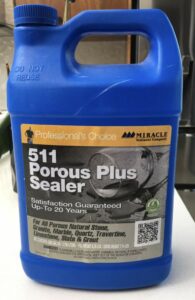
 If you have natural stone floors, it might not come as news to you that these floors are typically not finished when installed by developers. They might be polished, as a courtesy and possible selling point by the previous owner, but they probably have not been sanded or sealed. Within a month or two, you will notice your floors getting dull as the polish wears off with foot traffic.
If you have natural stone floors, it might not come as news to you that these floors are typically not finished when installed by developers. They might be polished, as a courtesy and possible selling point by the previous owner, but they probably have not been sanded or sealed. Within a month or two, you will notice your floors getting dull as the polish wears off with foot traffic.
I recently learned from a stone supplier that my floors are a blend of two types of Mexican travertine marble: Puebla marble and Veracruz marble. My developer most likely did this to hide the fact that he either ran out of one type of marble, or got a really good discount by buying mismatched pieces; either way, the colors blend well enough that I didn’t even notice until it was pointed out to me.
My floors were also poorly installed with many at varying heights causing me to trip when my flip-flops catch an edge. Worse than that, the unsealed floor leached rock dust causing my feet, and the feet of my white dogs, to be constantly dirty. This dust was impossible to get rid of with vacuuming and impossible to wash clean, as fine particles continually break away with wear.
When my floor refinisher Nettanel Lopez Hernandez, owner/operator of Pulido y Mantenimiento de Pisos, told me that I would have to re-polish my floors every two months to keep them in top-notch shape, I set about researching how to make these natural stone floors no-maintenance — or at least low-maintenance.
A friend from the United States, who is also a professional tiler, met with Nettanel and myself to discuss what needed to be done to improve these terrible floors. It was agreed:
- sand to level out the varying tile heights (a massive, labor intensive job)
- add grout to the many areas that lacked it
- replace the ugly aluminum border with a proper tile border
- fill in the numerous holes and cracks
- polish
- seal using a product called Miracle Sealant 511 Porous Plus Sealer. Expensive, but worth it!



COST:
In addition to the labor and equipment, $40,000 MXN ($2400 CAD or $2000 USD) would also include moving my furniture and covering with plastic draperies, cabinetry, and lights. The residual dust from sanding is as fine as icing sugar and gets into everything.
I purchased a 3.78 liter (1 gallon) bottle of Miracle Sealant 511 Porous Plus Sealer from amazon.com.mx for about $6,969 MXN ($420 CAD or $350 USD).
The cost of removing the aluminum edging and installing 31 linear meters (100 linear feet) of border tile would be an additional $15,000 MXN ($900 CAD or $750 USD). This part of the renovation still needs to be completed at the time of writing.
TIME COMMITMENT and STEPS INVOLVED:
It took five workers and seven full days to complete about 213 square meters (2,300 sq. ft.) of floor, with approximately one room being completed each day. The process was far more labor intensive than I could have imagined, but worth the money. Here is the process, and see for yourself, the results.
Step 1: Workers move furniture and cover everything with plastic (light fixtures, cabinetry, counters, draperies).
Step 2: Clean the tile
Step 3: Grind unlevel areas using high-abrasion diamond blades
Step 4: Clean residual rock dust from sanding process
Step 5: Polish and re-shine with glossy marble paste and crystallizers
Step 6: Apply Miracle Sealant 511 by hand and wipe off excess within 5 minutes
Step 7: Allow to dry about 2 hours
Step 8: Remove plastic
Step 9: Wash off residual rock (it still gets in behind the protective plastic)
Step 10: Move all furniture back into place

DURABILITY:
Opinions vary on this. I’ve heard from two to five years and that depends on wear. I prefer this process to having to re-polish every two months, not only with the expense, but the upheaval of my belongings each time.
Even with the disruption I would still recommend having your natural stone floors completely refinished if they are in bad shape; however, I would recommend having it done before you move in.
Better yet, get porcelain – just my opinion!
You can contact Nettanel Lopez to get an estimate at 998-131-6706 (Spanish only)









Leave a Reply